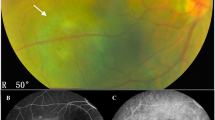Abstract
· Background: The presence of specific microvascularization patterns (networks, parallel with and without crosslinking, silent) in histological sections of human choroidal melanomas has prognostic significance for survival. We showed previously in selected patients that the identification of these microvascularization patterns is possible in vivo by using confocal scanning laser indocyanine green angiography and that this technique is superior to fluorescein angiography using a conventional acquisition technique with a fundus camera. We now routinely use simultaneous confocal fluorescein/indocyanine green angiography to study microvascularization patterns in choroidal melanomas. The purpose of this study was to compare the visibility of tumor vessels and microvascularization patterns in fluorescein and indocyanine green angiography in simultaneous confocal series taken with the same instrument in a large prospective series of patients. · Patients and methods: The simultaneously procured confocal fluorescein and indocyanine green angiograms of 50 patients with untreated choroidal melanomas (maximal apical height according to standardized A-scan between 2 and 8 mm) were studied for the visibility of tumor vessels and microvascularization patterns. At least one simultaneous confocal optical series (32 images in sequential depth order) during the early arterial venous phase was obtained per patient. · Results: Confocal forescein angiography disclosed signs of tumor vascularization in 12 (24%) of the 50 patients examined. However, in only 3 patients (6%) could microvascularization patterns be identified using confocal fluorescein angiography, and only in the very early arterial phase, which is often difficult to capture. In contrast, simultaneously obtained confocal indocyanine green angiograms disclosed tumor vessels in 47 (94%) of the examined 50 patients and microvascularization patterns could be identified in all of these cases. In 3 patients (6%) no tumor vessels could be detected within the tumor borders. · Conclusion: This study demonstrates that confocal indocyanine green angiography images microvascularization patterns in choroidal melanomas better than fluorescein angiography, even when the images are acquired with the same technique. This can be explained with the different absorption, fluorescence and exudation characteristics of these dyes. In vivo imaging of these microvascularization patterns using confocal indocyanine green angiography offers the possibility of assessing the prognosis of choroidal melanomas without the removal of tissue.
Similar content being viewed by others
Author information
Authors and Affiliations
Additional information
Received: 19 December 1997 Revised version received: 25 May 1998 Accepted: 10 September 1998
Rights and permissions
About this article
Cite this article
Mueller, A., Freeman, W., Folberg, R. et al. Evaluation of microvascularization pattern visibility in human choroidal melanomas: comparison of confocal fluorescein with indocyanine green angiography. Graefe's Arch Clin Exp Ophthalmol 237, 448–456 (1999). https://doi.org/10.1007/s004170050260
Issue Date:
DOI: https://doi.org/10.1007/s004170050260




